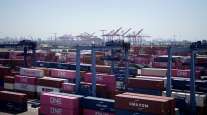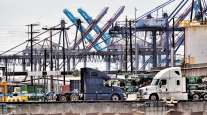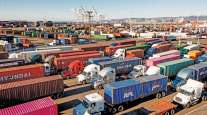Senior Reporter
West Coast Ports Slump While East Coast Facilities Weather Tariffs

[Stay on top of transportation news: Get TTNews in your inbox.]
Several of the nation’s most prominent ports felt the impact of the trade war between the United States and China as 2019 comes to a close, just as the Trump administration struck an initial trade agreement with China that is due to be signed sometime in 2020.
The Port of Los Angeles, the nation’s busiest, saw a 12.4% drop in cargo container volume in November, processing 728,918 20-foot-equivalent containers, or TEUs, compared with 832,330 in November 2018.
“As we expected, 2019 winds down with volumes weakening, due largely to the U.S.-China trade war which continues to negatively impact American consumers, manufacturers and U.S. supply chain jobs,” said Port of Los Angeles Executive Director Gene Seroka. “Although we anticipate tariffs will linger well into 2020, we will continue to aggressively invest in our physical and digital infrastructure through this economic cycle.”
It's here! The Dec. 2019 edition of the Port's Maritime Newsletter: Export volume increased in Nov.; First woman to lead Port's legal department appointed this month; Port hopeful, cautious over trade deal #PortofOakland #Oakland #PortAttorneyhttps://t.co/SHYuQXhNEV pic.twitter.com/42moVClflW — Port of Oakland (@PortofOakland) December 17, 2019
Thanks to robust activity during spring and summer, the port is still managing to run 0.4% ahead of 2018’s record pace.
The nearby Port of Long Beach also saw its cargo volumes drop in November, slipping 3.5% to 599,985 TEUs compared with 621,835 last year.
“The effects of these tariffs are being felt by everyone, from American manufacturers and farmers to the consumers who purchase goods moving through our port complex,” said Port of Long Beach Executive Director Mario Cordero.
The Port of Oakland saw a 10% drop in November, processing 197,344 TEUs compared with 219,125 last year. But officials there are cautiously optimistic the trade war is coming to an end.
“We’re hopeful that this is the beginning of the end to damaging trade restrictions,” Port of Oakland Executive Director Danny Wan said. “It’s a good sign for our shipping customers, but let’s see how it plays out. There’ll be more work ahead to get global trade flowing freely again.”
The Northwest Seaport Alliance, which operates ports in Seattle and Tacoma, Wash., said its November TEU numbers were down 15.1% when compared to 2018. This November, workers processed 271,178 TEUs compared with 319,242 in 2018.
It was a different story on the East Coast, where ports are less dependent on trade with China. Plus, East Coast facilities are also benefiting from new sea routes created by expansions of both the Panama Canal and the Suez Canal. Some facilities have spent billions of dollars on infrastructure improvements to help handle the larger cargo ships that come through these channels.
The Port of New York and New Jersey, the nation’s third-largest, saw a 2.7% year-over-year increase in TEU volume for November, processing 599,626 containers compared with 583,880 last year.
another fantastic shot of GPA's newest cranes arriving on the BigLift Baffin earlier this month. Three more cranes are set to arrive in the spring of 2020. Credit: @smortonfoto #BigShipReady #GeorgiaPorts #GaPorts pic.twitter.com/TmVt8xoFOM — Georgia Ports (@GaPorts) December 17, 2019
The Port of Georgia saw a 5.3% November increase, processing 362,964 TEUs compared with 344,506 in 2018. The facility needs to register just 112,000 TEUs for December to break its 2018 record of 4,238,342 TEUs, and the facility’s push to bring in new business should help. Officials have been focusing on serving markets such as Memphis, the Ohio River Valley and Chicago.
“Chicago plays such an important role in the nation’s logistics, not only as a major market but also as a cargo hub,” Georgia Port Authority Chairman Will McKnight said. “Breaking into that market with a new routing option that provides Savannah’s world-class terminal efficiency and customer service holds amazing potential to win new business.”
Georgia also saw a 5% uptick in roll-on, roll-off cargo, such as cars, farm equipment and other wheeled cargo. It is now the second-busiest port in the country for such cargo, trailing the Port of Baltimore.
The Charleston Harbor Deepening Project reached a monumental milestone today with President Donald Trump and Congress officially greenlighting $138 million for the Charleston Harbor Deepening Project. #theworldconnectshere #chs52 https://t.co/jrT0Qcyne8 pic.twitter.com/768sf8dXlr — South Carolina Ports (@SCPorts) December 21, 2019
Not every East Coast port reported gains. The Port of Charleston saw a 1.9% decrease in November, moving 184,928 TEUs compared with 188,583 in 2018. Even so, for the first six months of its fiscal year the port is running 6% ahead of 2019’s pace. “Looking ahead to 2020, we expect to continue weathering uncertainty in the world economy, but our strong position in the Southeast and proximity to a booming consumer market will drive growth,” Port CEO Jim Newsome said. “We expect to grow above the market as more cargo shifts from West Coast to East Coast ports.”
Long-term infrastructure improvements should help; on Dec. 20, the facility received $138 million in federal money to deepen the harbor to 52 feet in 2021. The Port of Virginia is also deepening its shipping channel, to 55 feet, which will make it the deepest on the East Coast. The project will cost $350 million, and when it’s done in 2024, the port will be able to accommodate two ultra-large container vessels side by side.
In November, the facility reported a 5.3% drop in TEU volume to 226,982 from 239,890 in 2018.
“The trade environment continues to present challenges, and we are adapting,” Virginia Port Authority CEO John Reinhart said.
Want more news? Listen to today's daily briefing:




